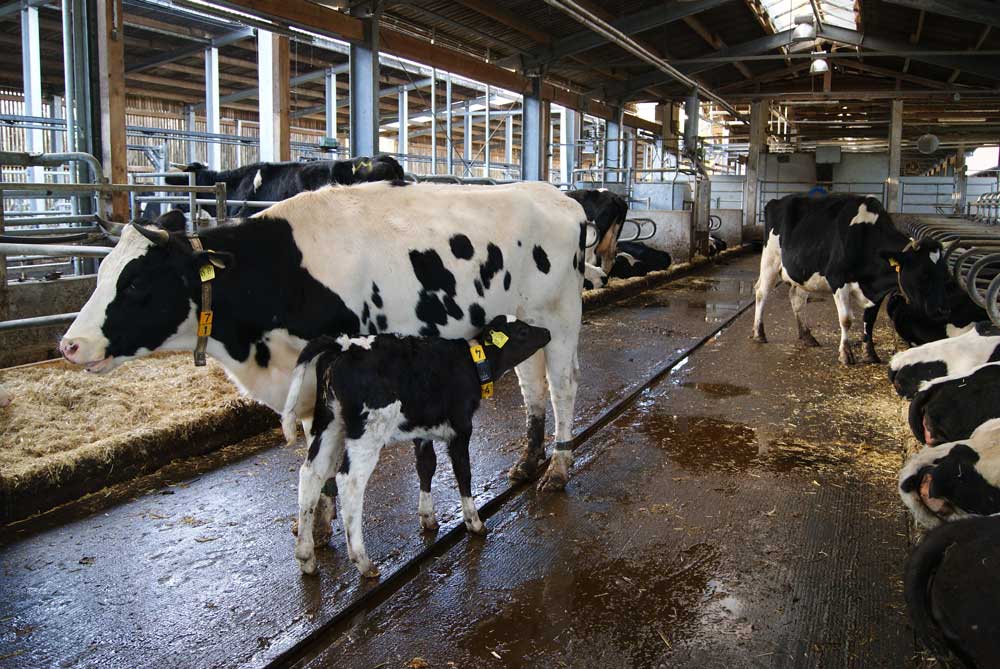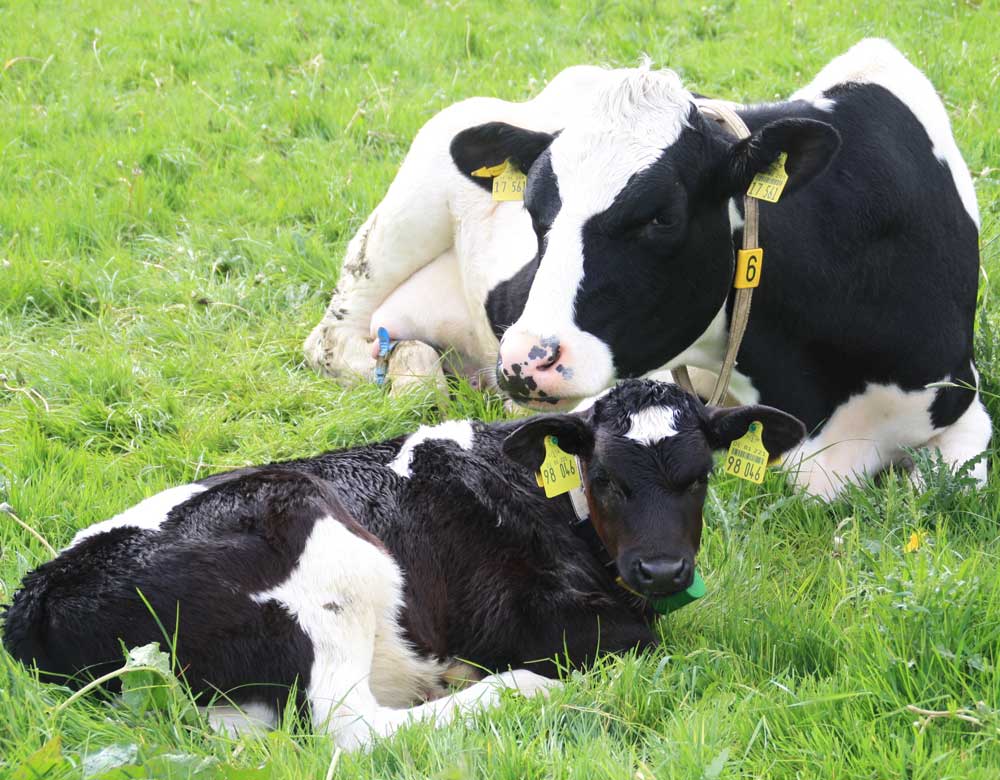Leaving the calf longer with the cow?
By Hauke Tergast, Thünen Institute of Farm Economics, Wiebke Schumacher, Göttingen University, Dr Kerstin Barth, Thünen Institute of Organic Farming.
By Hauke Tergast, Thünen Institute of Farm Economics, Wiebke Schumacher, Göttingen University, Dr Kerstin Barth, Thünen Institute of Organic Farming.
Allowing a dairy calf to suckle its mother for a longer period – so-called mother bonded rearing - is seldom seen in the modern dairy herd. Only very few, mainly organically managed, herds offer calves periodical suckling access, or the opportunity to suckle right through to weaning. But might keeping cow and calf together longer be a good marketing argument for selling milk from the herd? With this question in mind, farmer interest in mother bonded rearing is growing. The advantages of quick separation of calf and mother postpartum are obvious: easier health control; reduced separation stress for both, with less related unrest within the herd. Early removal also supports efficient management routines with larger herds and calf groups. On the other hand, quick separation prevents cow and calf following natural behavioural traits, a deprivation that has been shown to affect social behaviour of calves. |
More milk required
At the Thünen Institute of Organic Farming in Trenthorst, Germany mother bonded calf rearing trials have been conducted since 2003. Serving as control groups are always calves separated early from their mothers and reared with the help of automatic milk replacer dispensers. Recorded are health and performance of the different calf groups, but also milk production and milk quality from the respective cows. The trials now also compare costings from mother bonded rearing and automatic milk dispenser rearing. Based on results from different trials, key economic figures are compared for two 40-head groups of calves.
With permanent cow-calf contact, calves suckle anytime they want. This results in more milk being consumed compared with conventional early separation systems. It is worthwhile noting here that it is very difficult to exactly record milk consumed by suckling calves. Comparison was thus achieved by using results from a group pf cows milked purely by machine after being separated from their calves immediately postpartum. The milk produced was compared with the much lower total of saleable milk retrieved by machine from the mother bonded group, the difference representing the greatest cost factor in the experiment.
With a ninety-day suckling phase with whole milk, as required under organic husbandry rules, consumption averaged 1319 kg of milk or 15.5 kg/day. The opportunity costs (based on the milk unable to be sold) are accordingly high. If the calves had been raised conventionally with an average 10.6 kg fed daily, the required amount of milk would be 898 kg, giving a difference of 421 kg/calf.
Milk fat penalty
At the same time, the composition of milk where the cows were suckled was found to alter. Milk ejection was inhibited when the suckled cows were machine milked, meaning fat-rich milk was not fully removed from the alveolar gland. Fat content of the machine milked milk was an average one percentage point lower as a result, which would negatively affect the price received.
In an organically managed farm the result would be an income penalty of 246 € (assuming an average price of 49 c/kg in 2017). Conventionally managed farms do not have to use whole milk in calf feeding, instead following colostrum feeding with lower cost milk replacer. Comparing the costs of whole milk feeding within mother bonded rearing and those for 35% skim milk replacer feeding, the skim milk system costs 399 € less.
Additional costs of 137 €
The overview shows the most important cost differences for the mother bonded organic rearing approach and mother bonded rearing in a conventional system. Most noticeable are the savings through the mother bonded conventional approach by using milk replacer. Other cost differences between the different rearing methods include those linked to housing area, materials and machinery as well as labour costs which are reduced in mother bonded rearing through less work input being required.
In total, mother bonded calf rearing is shown to be 137 € per calf dearer under organic rules. When compared with a conventionally managed farm, the extra costs under the organic system total 303 € per calf, the difference being greater because here, milk-replacer can be used for feeding the separated calves. Not taken account of are eventual building alteration costs. On the trial farm, the calf housing and cow loose housing are adjacent. Through a door, which can only be used by the suckling calves, the young animals can access and suckle their mothers whenever they want. In summer, cows and calves pasture together.
Health
Trial results so far have identified no important health differences between mother bonded and conventionally reared calves. However, the former returned higher growth rates and so greater weaning weights than the conventionally reared calves. While the differences in bodyweight were resolved by first calving, trials with other working groups featuring feeding with ad lib milk also indicated possible effects on immune system development. The economic values involved have not yet been calculated,
Summary
While the cost structures described here apply only to the trial farm analysis, the values arrived at can offer indications on, for instance, how high added income would have to be to make mother bonded calf rearing financially viable, with the necessary marketing input. The trial results indicate that mother bonded calf rearing on conventionally managed farms is associated with higher costs compared with cow-calf separation systems because, in the latter, lower cost milk replacer can be offered. On organically managed farms where natural whole milk must be used for calf feeding in both systems, the difference is not so great. There are examples where individual farms have been able to achieve an added value for the milk marketed from cows where calves are reared mother bonded. Therefore, the aim should be to recover the extra costs involved, for instance via direct marketing of the milk.
What is cow bonded calf management?
Compared with mother bonded calf rearing, »cow bonded« rearing is a term that also includes rearing using foster cows. The methods used for cow bonded rearing are very diverse, being characterised in more detail by the following factors:
- Contact to adult animals. This may involve the real mother but can also be a group of foster cows. The situation can also change during the rearing period: first mother contact, then further rearing with foster mothers.
- Period of contact with cow. Hereby is meant the rearing time while suckling. This is very different from farm to farm, ranging from at least three weeks to four or five months.
- Daily contact to cow. Here, a difference is made between permanent and temporary contact during the day, whereby contact every now and again each day before or after machine milking, or only at a certain period between milking, (daytime or at night) can occur.
- Additional drink on offer. As well as milk from the cow, the calf can be offered milk from other sources. This eases weaning.
- Weaning methods. With cow bonded rearing, separation of cow and calf has, of course, to take place eventually. And here too, there are very different methods. For instance, through gradual lengthening of daily separation times. So-called suckling preventers can be used to ease separation from cow and from milk, whereby preventers these must not obstruct intake of other feeds. Weaning can also be aided by using an udder net, or through so-called »fenceline weaning« by which the animals can still maintain contact through a railing.





